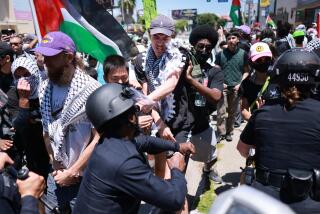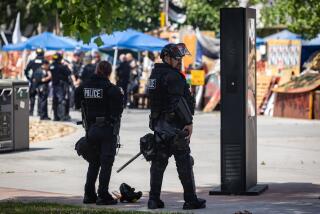Confrontation at 1967 Antiwar Protest
- Share via
When I read Kenneth Reich’s June 23 article about the 1967 protest march, it brought back lots of memories. I was one of the marchers, along with a few of my “middle-class liberal” friends. When we heard the order to disperse and tried to do so, we were told by a policeman to stay where we were. To this day, I have always believed that both the police and the radical element really wanted a confrontation. In any case, I’m glad I was there to be part of such a historic occasion.
BETTE K. LEONARD
Sherman Oaks
* I was outraged by one statement attributed to me: “When a reporter quoted to Reddin a male demonstrator’s recollection that the Century Plaza confrontation marked the first time he had ever seen ‘white women’ beaten by police, Reddin agreed that had happened.” Let the record show I did not agree that any women were beaten by police in Century City on June 23, 1967.
Necessary force was used in the dispersal of participants in a parade that had become a mob, but we should not forget we were dealing with the safety of the president.
THOMAS REDDIN
Chief of Police, Ret., LAPD
* The one quote attributed to me was inaccurate to the degree that the reporter’s “interpretation” of what I stated totally changed the meaning and context of what I said.
Further, I carefully described my investigators having developed information regarding a serious plan to assassinate President Johnson, a fact which could have easily been confirmed through the LAPD, the L.A. County district attorney’s Bureau of Investigation and the Secret Service, with whom I worked very closely at that time.
DAVID L. BERGER
(Former owner of International
Investigations Systems)
Las Vegas
* There are many of us still in Los Angeles who clearly remember the Century City march on June 23, 1967. My husband and I and our 3-year-old son wanted to protest the war in Vietnam. My husband thought it safest for us to park beneath the shopping center and observe the march from its intended ending spot north of the Century Plaza Hotel. Here is what we observed:
The police had erected barricades directly in front of the hotel, but these barricades were set to condense the crowd as they got in front of the hotel. This created a bottleneck that marchers toward the rear could not see, so they continued to march forward.
When it seemed that the police were effectively starting a riot, we quickly left. As soon as we got to our car we turned on the radio. Every station was reporting the massive war protest and the ongoing disturbance. But here’s the strangest thing: Despite the presence of news camera vans from the major networks and a couple of local channels, by the time we got home to West Hollywood there wasn’t an inch of videotape to be seen! By the 11 p.m. news, the numbers of the marchers had been scaled down to half or less of what the earlier estimates had been on the radio as the protesters assembled. The descriptions of violent police behavior were diluted to meaninglessness. The damage to civilians peacefully protesting government policies was minimized and the protesters characterized as wild-eyed fanatics.
How odd that the press now venerates this event as a turning point in Lyndon Johnson’s presidency and in the war protest movement. Who called for a lid to be put on truth in reporting in 1967? Why did the media listen?
MICHELE HART-RICO
Hollywood
More to Read
Sign up for Essential California
The most important California stories and recommendations in your inbox every morning.
You may occasionally receive promotional content from the Los Angeles Times.










